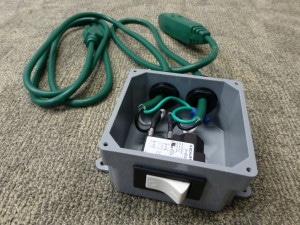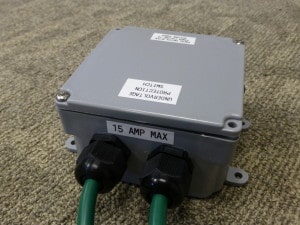I recently built a device that is very useful but is hard to find commercially, and even information was scarce about how to build one myself, so I’m posting the details here in hopes that it helps anyone who might be looking for a similar device.
It’s called an undervoltage protection switch. In Europe, it’s commonly called a no-volt release switch. What does it do? It is basically a switch that, once turned on, will stay on as long as power is applied to it. But if the power goes out or falls below a certain level (like during a brown-out), then the switch will shut off. If the power comes back on, the switch will not be activated until someone manually presses the button. Another way to think of it is that it’s a circuit breaker that trips when the power goes out instead of when there’s a power surge or over-current issue.  What is it good for? We have some equipment that can behave strangely after a power failure, like peristaltic pumps that are used to precisely control the flow rate of water to an experiment. They are always turned on manually and then the user sets various speed controls to adjust the flow of water. But after a power outage, the pumps come back on by themselves once the power is restored, and they usually revert back to their default speed settings, which can be a major problem for the experiment. So by putting this switch box inline between the pump and the wall outlet, we can be sure the pump will never turn on by itself after an outage. To build it, I used a rocker-type undervoltage protection switch (there are various options, depending on your operating voltage and current capacity), an extension cord, some cable glands, and a plastic conduit junction box.
What is it good for? We have some equipment that can behave strangely after a power failure, like peristaltic pumps that are used to precisely control the flow rate of water to an experiment. They are always turned on manually and then the user sets various speed controls to adjust the flow of water. But after a power outage, the pumps come back on by themselves once the power is restored, and they usually revert back to their default speed settings, which can be a major problem for the experiment. So by putting this switch box inline between the pump and the wall outlet, we can be sure the pump will never turn on by itself after an outage. To build it, I used a rocker-type undervoltage protection switch (there are various options, depending on your operating voltage and current capacity), an extension cord, some cable glands, and a plastic conduit junction box.  I cut the extension cord in half and routed it into the box using the cable glands. The glands keep the cables secure to the box, and even though I use these types of glands on our outdoor enclosures to keep water out, this device is not suitable for wet locations, since the rocker switch isn’t waterproof. The switch uses the power from the line leads to hold the relay closed, allowing power to flow to the load line. This switch is rated for 15 amps AC. You can find other versions that work for different AC or DC voltage ranges.
I cut the extension cord in half and routed it into the box using the cable glands. The glands keep the cables secure to the box, and even though I use these types of glands on our outdoor enclosures to keep water out, this device is not suitable for wet locations, since the rocker switch isn’t waterproof. The switch uses the power from the line leads to hold the relay closed, allowing power to flow to the load line. This switch is rated for 15 amps AC. You can find other versions that work for different AC or DC voltage ranges.

 Welcome to EnviroDIY, a community for do-it-yourself environmental science and monitoring. EnviroDIY is part of
Welcome to EnviroDIY, a community for do-it-yourself environmental science and monitoring. EnviroDIY is part of